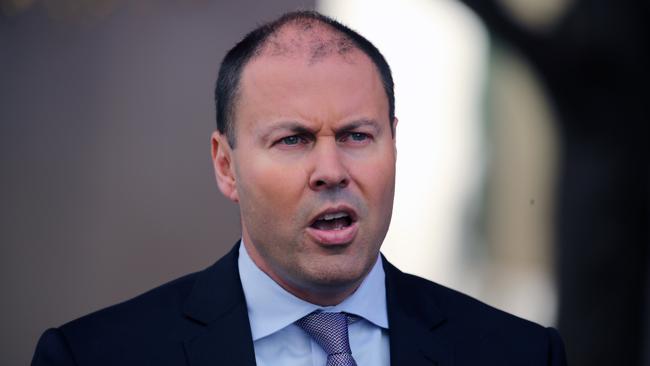
This may sound strange but the renewable energy industry — I prefer to call it the unreliable energy industry — is overjoyed by the public discussion about the need for new coal-fired electricity plants to be built here.
The rent-seekers — the owners of wind farms and solar installations — know there will be no investment in coal-fired electricity, certainly not in terms of new plants. Even investment in maintaining or extending the lives of existing coal-fired plants is rationed.
New coal-fired plants are unbankable, given the policy settings. They cost a lot, their economic lives are too long and the risks are too high.
The only scenario in which a new high-efficiency, low-emissions plant can be built — and plenty are overseas — is government ownership. Even then, the delay before commissioning would be three to five years. There are no circumstances under which the Coalition under Malcolm Turnbull will agree to the government building, owning and operating a HELE plant.
As for Labor, it doesn’t even know what a HELE plant is; its intention is to head in the nonsensical direction of 50 per cent renewables (globally, wind and solar account for 8 per cent of electricity generation) and a higher emissions reduction target.
So why are the renewables players so excited about the ongoing discussion of investment in new coal-fired plants that will never happen? It diverts attention from the main game, which is the definition of reliability that will apply in the new policy framework, the national energy guarantee.
They also are seeking to have other features of the final design favour renewable energy, including the restrictions on the use of carbon offsets, both local and international, to meet the emissions reduction target. There is even a possibility that there will be no allowance for offsets in the final version.
While Energy Minister Josh Frydenberg feels pleased with himself that he has secured reasonably broad support for the national energy guarantee — there are a few exceptions — everyone knows that it will come down to the detail. It shouldn’t surprise anyone that the latest iteration of the guarantee was released last Friday at 5pm.
Let me outline three key weaknesses in it. They are: the lack of a defensible definition of reliability; the way the emissions reduction target is put into effect; and the use of offsets. (I apologise for the technical nature of some of this discussion — it’s unavoidable.)
The most appropriate way of defining reliability — supply meeting demand when and where it is required — is to map out scenarios in which renewable energy sources plus other sources will not be able to meet the needs of the market and to identify the back-up arrangements that can be relied on. It can’t be an averaging process; extremes must be considered.
Note, for example, that extended wind droughts can occur; witness Germany and Britain recently. It also can be cloudy for extended periods. These back-up options include battery, pumped hydro, gas peaking or even diesel generators.
They may be uncommon events, but because Australia’s electricity grid is self-contained (we can’t import electricity from other countries, as is the case in Europe) we must plan for them.
One of the papers released last Friday simply states that “a reliable system is one with enough energy (generation and demand side participation) and network capacity to supply consumers — this implies that there should be enough energy to meet demand, with a buffer known as reserves”. A key carve-out is “demand side participation”.
The game that the renewable energy sector is playing is to define the scenario for which back-up is required on terms that suit it. Instead of meeting demand when and where it is required, its preferred alternative is to assume that demand is managed down (all big industrial users are expected to reduce their use of power as well as some households) before there is any need to provide back-up.
In this way, the renewable energy industry will be able to point to a motley collection of diesel generators and a few batteries (which provide power for a few hours at most), which will allow the retailers to meet the reliability requirement under the terms of the national energy guarantee. It’s a neat trick because it avoids the expensive exercise of providing or contracting for true back-up
This sort of demand management is Third World stuff and the clear danger is that these big users will just power down forever, particularly as they are also being told they have to provide back-up themselves. They have made it very clear that they cannot rely on renewable energy. So when contracts expire, they will simply shut up shop and relocate overseas.
When it comes to how the national energy guarantee will work, demand forecasts will be made out to 2030. The renewable energy industry will seek to have these forecasts low-balled because this will accelerate the exit of older baseload coal-fired plants as well as reduce the need for back-up.
These demand forecasts will then translate into an abatement number by 2030 (the reduction in tonnes of CO2) and from this an emissions intensity target will be calculated. It will be of the order of 0.4 per megawatt hour, which knocks out all coal, and gas will be used only as a peaker. The national energy guarantee is effectively an emissions intensity scheme.
An abatement trajectory will have to be set for the decade, but the minister already has ruled out back-ending the emissions reduction task even though it would be very sensible to wait to see what the rest of the world does. Note that last year global emissions rose by 1.6 per cent. There may be some scope for small overs and unders from year to year, but this doesn’t really address the problem.
Having made our commitment to the Paris climate agreement and fallen into the trap of not subtracting the emissions of energy-intensive exporters as other nations have — the target would be 21 per cent to 23 per cent, rather than 26 per cent to 28 per cent, if we had done this — the best way forward is to allow retailers to acquit their emissions reduction requirements by buying carbon offsets.
These can be local — Australian carbon credit units (think local carbon farming) — and international. Either way, it is a far cheaper way of making our contribution to emissions reduction than through the labyrinthine national energy guarantee. (We will have to stop calling it the National Electricity Market; it simply won’t meet any definition of a market given the heavy-handed regulation, excessive direction and high penalties.)
The bottom line is the renewable energy industry has won. And this includes the big three vertically integrated players since they are heavily invested in renewables but will be able to milk their baseload assets in the interim.
Prices may be plateauing at the moment, but they will continue their upward path soon. Liddell will close in 2022, but it is in such a shocking state of disrepair its output will be unreliable in the meantime. The grid is regularly close to breaking point now. Large-scale, energy-intensive plants will close across time, leaving an economy dominated by the service sector and government. We will have thrown away one of our greatest sources of comparative advantage: cheap, reliable electricity.






To join the conversation, please log in. Don't have an account? Register
Join the conversation, you are commenting as Logout